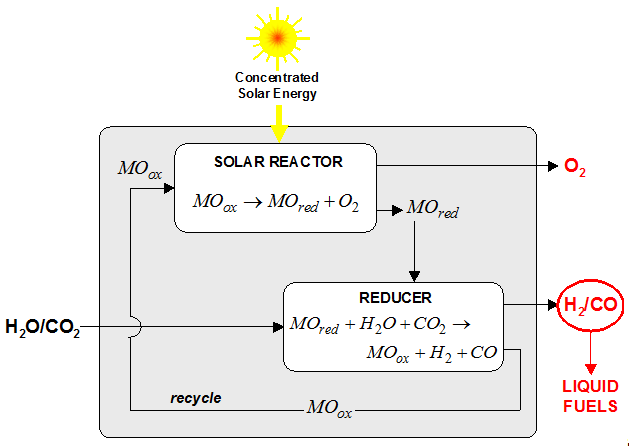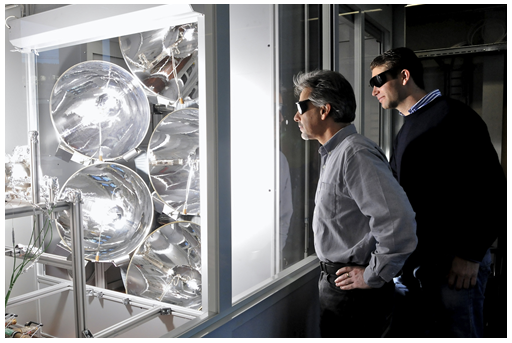EU-Project SOLARJET – Solar Production of Jet Fuel from H2O and CO2
Website: external page https://cordis.europa.eu/project/id/285098
Funding source: external page European Union
Partners: external page SHELL Global Solutions International B.V; external page German Aerospace Center (DLR), Institute of Combustion Technology;external page ARTTIC; external page Bauhaus Luftfahrt e.V
Postdoc: Dr. Philipp Furler
Background – Solar thermochemical approaches to splitting CO2 and H2O inherently operate at high temperatures and utilize the entire solar spectrum, and as such provide an attractive path to solar fuels production with high energy conversion efficiencies in the absence of precious metal catalysts. In contrast to direct thermolysis of CO2 and H2O, two-step thermochemical cycles using metal oxide redox reactions further bypass the CO/O2 or H2/O2 separation problem. Figure 1 shows schematically the proposed two-step H2O/CO2 splitting thermochemical cycle based on metal oxide redox reactions, encompassing:
- an endothermic reduction of the metal oxide into a metal or reduced-valence metal oxide and O2 evolution using concentrated solar radiation as the source of high-temperature process heat; and
- an exothermic reaction of the reduced metal/metal oxide with H2O/CO2 which yields H2/CO, together with the initial form of the metal oxide; the latter is recycled to the first step.
The net reactions are H2O= H2+½O2 and/or CO2 = CO+½O2,. Since O2 and H2/CO are released in separate steps, the need for high-temperature gas separation is thereby eliminated. The syngas mixture H2/CO can be further processed to liquid hydrocarbon fuels (via Fischer-Tropsch and other catalytic processes), such as diesel, kerosene, methanol, and gasoline using existing conventional technologies.

Cerium oxide (ceria) has emerged as a highly attractive redox active material choice because it displays rapid fuel production kinetics and high selectivity. Reduction proceeds via the formation of oxygen vacancies and the release of gaseous O2, resulting in the subsequent change in stoichiometry (x). Oxidation is capable of proceeding with H2O and/or CO2, thereby releasing H2and/or CO and re-incorporating oxygen into the lattice. The two-step H2O/CO2 splitting solar thermochemical cycle based on oxygen-deficient ceria is represented by:
High-T reduction: CeO2 → CeO2-x + x/2O2 (1)
Low-T oxidation with H2O: CeO2-x + xH2O → CeO2 + xH2 (2a)
Low-T oxidation with CO2: CeO2-x + xCO2 → CeO2 + xCO (2b)
Recently, within the framework of a joint collaboration between ETH Zurich, PSI, and the California Institute of Technology, a solar chemical reactor was tested at PSI’s High-Flux Solar Simulator for the CeO2-δ / CeO2-δ-x solar thermochemical cycle [Ref. Science 2010]. This first-generation solar reactor prototype, shown schematically Figure 2, consisted of a cavity-receiver containing a highly porous ceria tube that was directly exposed to concentrated solar radiation


Objective – The aim of the SOLAR-JET project is to demonstrate a carbon-neutral path for producing aviation fuel, compatible with current infrastructure, in an economically viable way. The SOLAR-JET project will demonstrate on a laboratory-scale a process that combines concentrated sunlight with CO2 and H2O to produce kerosene by coupling a two-step solar thermochemical cycle based on non-stoichiometric ceria redox reactions with the Fischer-Tropsch process. This process provides a secure, sustainable and scalable supply of renewable aviation fuel, and early adoption will provide European aviation industries with a competitive advantage in the global market. The collaborators within SOLAR-JET combine all necessary competencies for the realization of project objectives, including: a unique high-flux solar simulator, a state-of-the-art computer simulation facility and software to significantly reduce the required number of experiments, and a Fischer-Tropsch unit for producing the first ever solar kerosene. These efforts are further complemented by assessments of the chemical suitability of the solar kerosene, identification of technological gaps, and determination of the technological and economical potentials. The outcomes of SOLAR-JET would propel Europe to the forefront in efforts to produce renewable, aviation fuels with a first-ever demonstration of kerosene produced directly from concentrated solar energy. The fuel is expected to overcome known sustainability and/or scalability limitations of coal/gas-to-liquid, bio-to-liquid and other drop-in biofuels while avoiding the inherent restrictions associated with other alternative fuels, such as hydrogen, that require major changes in aircraft design and infrastructure. The process demonstrated in SOLAR-JET eliminates logistical requirements associated with the biomass processing chain and results in much cleaner kerosene and represents a significant step forward in the production of renewable aviation fuels.
ETH Zurich’s role within the SOLARJET project is to:
- formulate and experimentally validate a reactor model for heat/mass transfer and fluid flow.
- develop and optimize the solar reactor technology for producing syngas by splitting H2O and CO2, and to further process the syngas to kerosene (jet fuel).
Project-related Publications